Global Warming and Health: The Role of Climate Change on Zika Virus
VerifiedAdded on 2020/04/21
|9
|2076
|197
Report
AI Summary
This report investigates the link between climate change and the Zika virus, identifying it as a significant biological stressor. It explores how rising temperatures and altered weather patterns create favorable conditions for the Aedes mosquito, the vector of the Zika virus, leading to outbreaks. The report details the historical evidence, statistical models, and early impact assessments that demonstrate this connection. It also examines the virus's impact on global populations, emphasizing the role of environmental and social determinants of health. Furthermore, the report outlines various prevention and control strategies, including vector control through mosquito interception, reducing human exposure, and limiting mosquito breeding grounds. It also discusses innovative approaches like genetically modifying mosquitoes and introducing Wolbachia bacteria to reduce virus transmission. The report concludes by emphasizing the importance of understanding and addressing the health risks associated with climate change, particularly in the context of emerging infectious diseases like Zika.
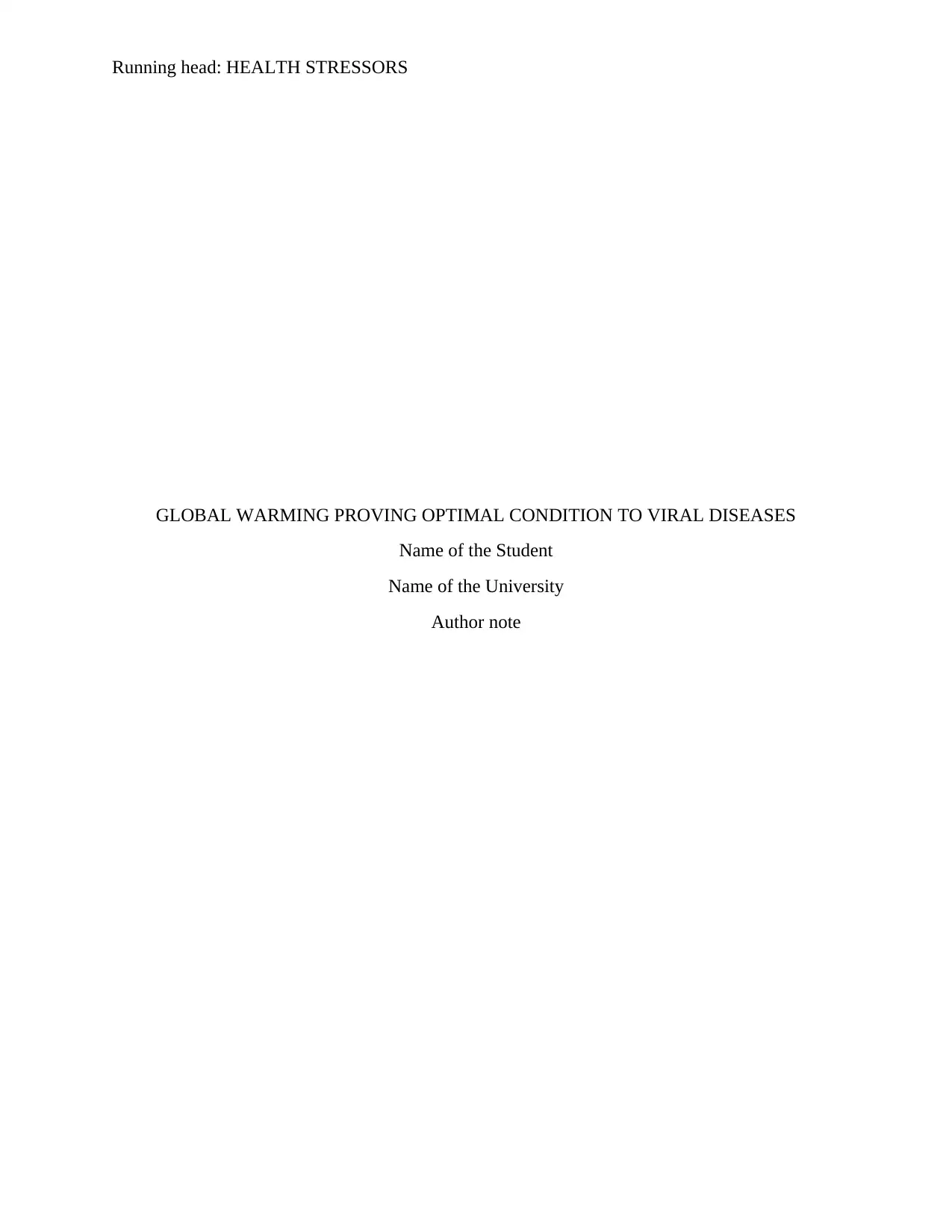
Running head: HEALTH STRESSORS
GLOBAL WARMING PROVING OPTIMAL CONDITION TO VIRAL DISEASES
Name of the Student
Name of the University
Author note
GLOBAL WARMING PROVING OPTIMAL CONDITION TO VIRAL DISEASES
Name of the Student
Name of the University
Author note
Paraphrase This Document
Need a fresh take? Get an instant paraphrase of this document with our AI Paraphraser
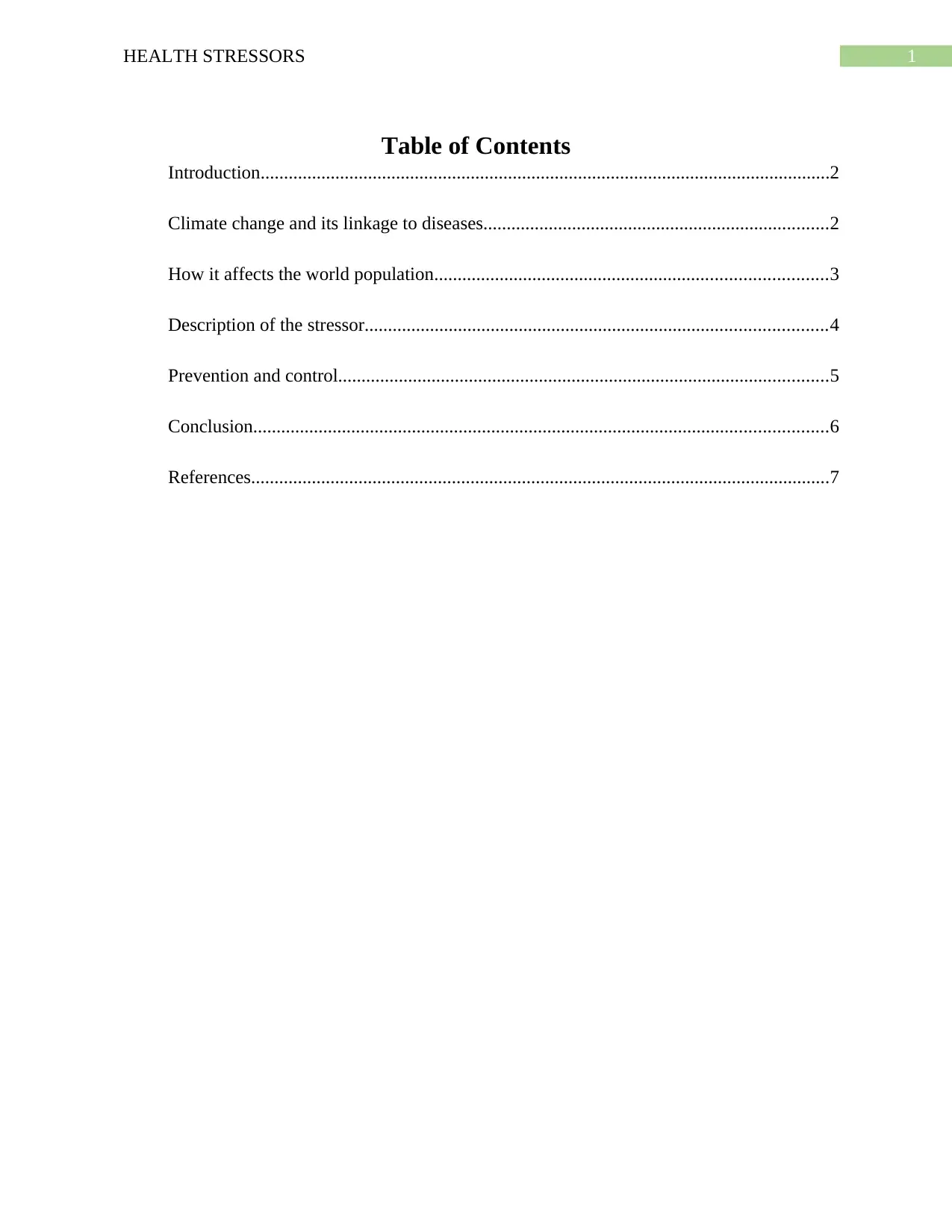
1HEALTH STRESSORS
Table of Contents
Introduction..........................................................................................................................2
Climate change and its linkage to diseases..........................................................................2
How it affects the world population....................................................................................3
Description of the stressor...................................................................................................4
Prevention and control.........................................................................................................5
Conclusion...........................................................................................................................6
References............................................................................................................................7
Table of Contents
Introduction..........................................................................................................................2
Climate change and its linkage to diseases..........................................................................2
How it affects the world population....................................................................................3
Description of the stressor...................................................................................................4
Prevention and control.........................................................................................................5
Conclusion...........................................................................................................................6
References............................................................................................................................7
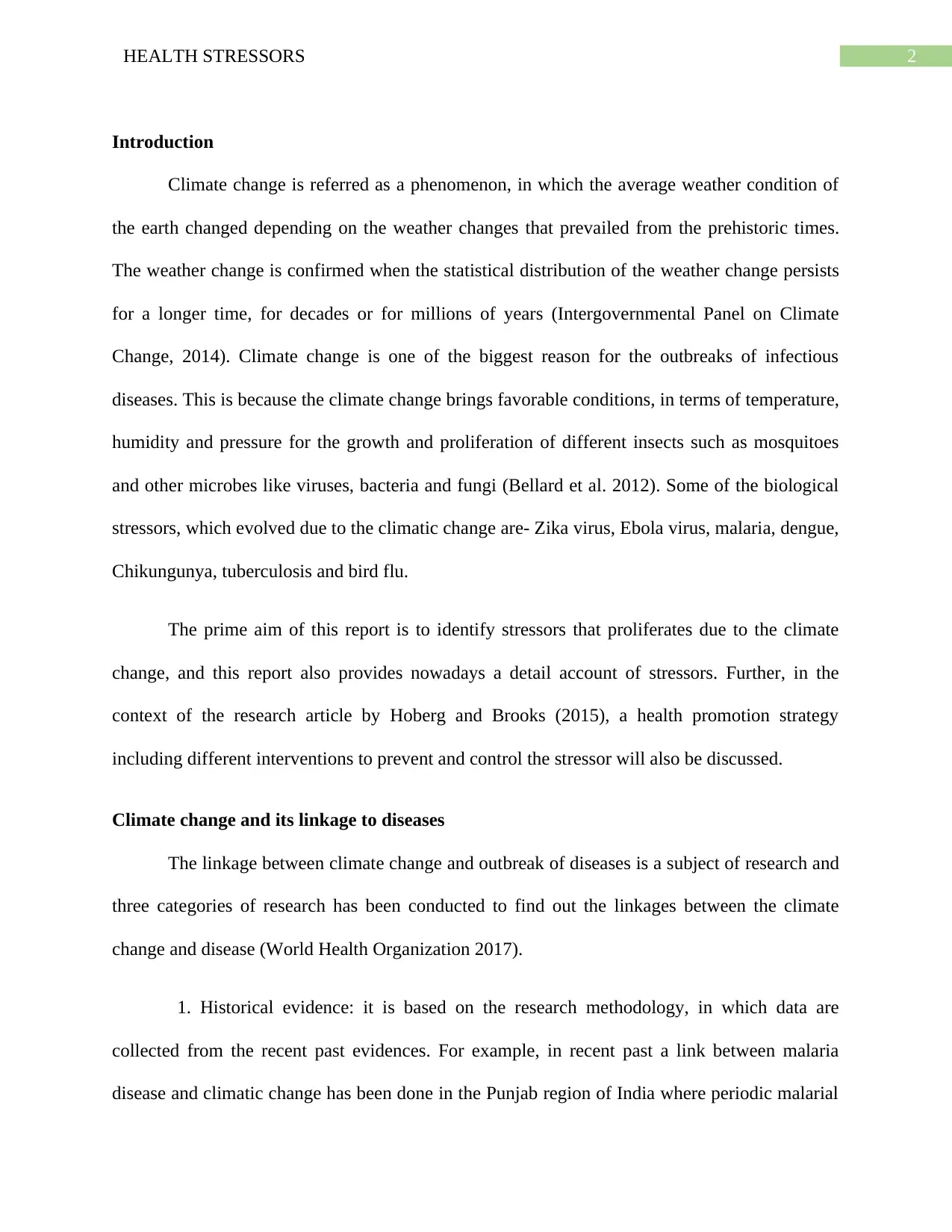
2HEALTH STRESSORS
Introduction
Climate change is referred as a phenomenon, in which the average weather condition of
the earth changed depending on the weather changes that prevailed from the prehistoric times.
The weather change is confirmed when the statistical distribution of the weather change persists
for a longer time, for decades or for millions of years (Intergovernmental Panel on Climate
Change, 2014). Climate change is one of the biggest reason for the outbreaks of infectious
diseases. This is because the climate change brings favorable conditions, in terms of temperature,
humidity and pressure for the growth and proliferation of different insects such as mosquitoes
and other microbes like viruses, bacteria and fungi (Bellard et al. 2012). Some of the biological
stressors, which evolved due to the climatic change are- Zika virus, Ebola virus, malaria, dengue,
Chikungunya, tuberculosis and bird flu.
The prime aim of this report is to identify stressors that proliferates due to the climate
change, and this report also provides nowadays a detail account of stressors. Further, in the
context of the research article by Hoberg and Brooks (2015), a health promotion strategy
including different interventions to prevent and control the stressor will also be discussed.
Climate change and its linkage to diseases
The linkage between climate change and outbreak of diseases is a subject of research and
three categories of research has been conducted to find out the linkages between the climate
change and disease (World Health Organization 2017).
1. Historical evidence: it is based on the research methodology, in which data are
collected from the recent past evidences. For example, in recent past a link between malaria
disease and climatic change has been done in the Punjab region of India where periodic malarial
Introduction
Climate change is referred as a phenomenon, in which the average weather condition of
the earth changed depending on the weather changes that prevailed from the prehistoric times.
The weather change is confirmed when the statistical distribution of the weather change persists
for a longer time, for decades or for millions of years (Intergovernmental Panel on Climate
Change, 2014). Climate change is one of the biggest reason for the outbreaks of infectious
diseases. This is because the climate change brings favorable conditions, in terms of temperature,
humidity and pressure for the growth and proliferation of different insects such as mosquitoes
and other microbes like viruses, bacteria and fungi (Bellard et al. 2012). Some of the biological
stressors, which evolved due to the climatic change are- Zika virus, Ebola virus, malaria, dengue,
Chikungunya, tuberculosis and bird flu.
The prime aim of this report is to identify stressors that proliferates due to the climate
change, and this report also provides nowadays a detail account of stressors. Further, in the
context of the research article by Hoberg and Brooks (2015), a health promotion strategy
including different interventions to prevent and control the stressor will also be discussed.
Climate change and its linkage to diseases
The linkage between climate change and outbreak of diseases is a subject of research and
three categories of research has been conducted to find out the linkages between the climate
change and disease (World Health Organization 2017).
1. Historical evidence: it is based on the research methodology, in which data are
collected from the recent past evidences. For example, in recent past a link between malaria
disease and climatic change has been done in the Punjab region of India where periodic malarial
⊘ This is a preview!⊘
Do you want full access?
Subscribe today to unlock all pages.

Trusted by 1+ million students worldwide
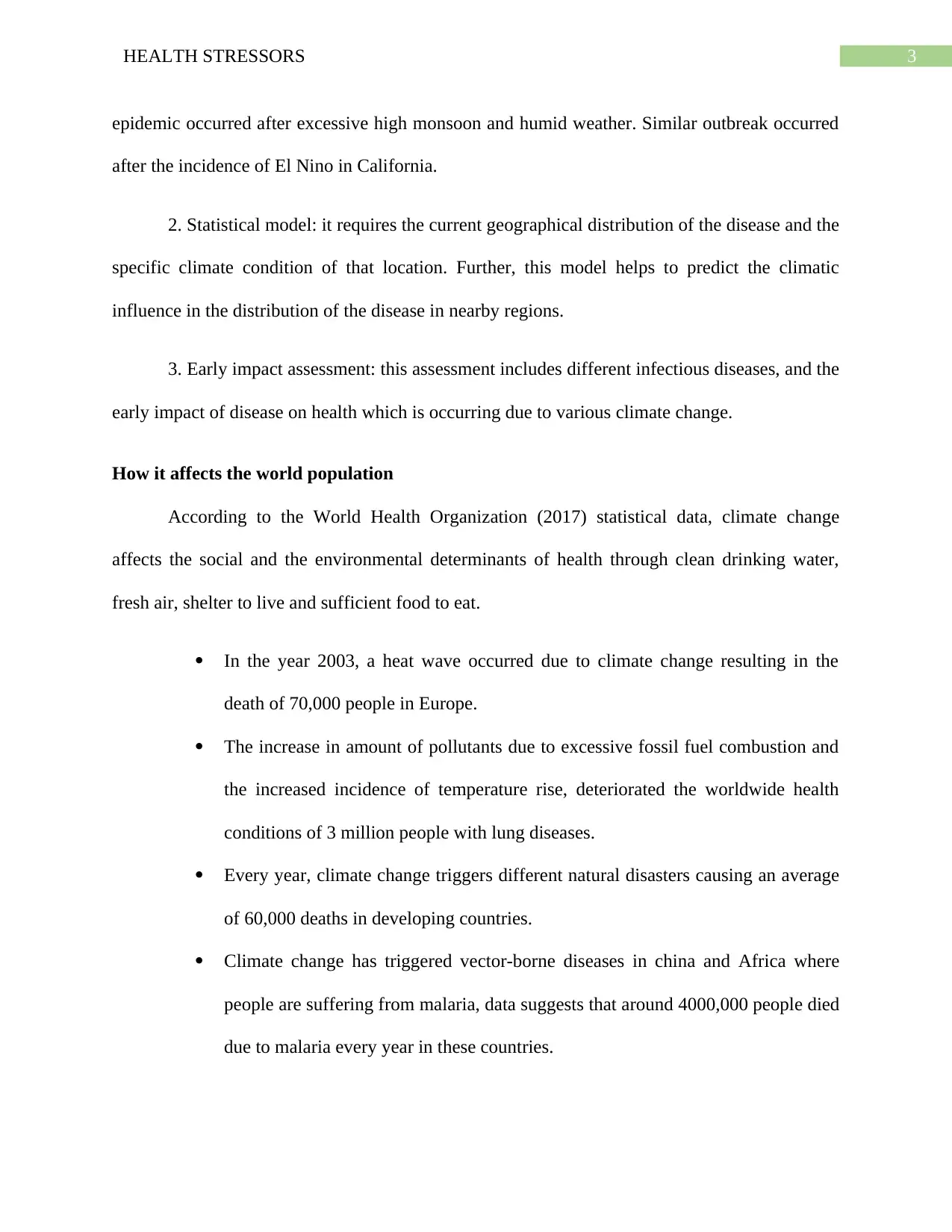
3HEALTH STRESSORS
epidemic occurred after excessive high monsoon and humid weather. Similar outbreak occurred
after the incidence of El Nino in California.
2. Statistical model: it requires the current geographical distribution of the disease and the
specific climate condition of that location. Further, this model helps to predict the climatic
influence in the distribution of the disease in nearby regions.
3. Early impact assessment: this assessment includes different infectious diseases, and the
early impact of disease on health which is occurring due to various climate change.
How it affects the world population
According to the World Health Organization (2017) statistical data, climate change
affects the social and the environmental determinants of health through clean drinking water,
fresh air, shelter to live and sufficient food to eat.
In the year 2003, a heat wave occurred due to climate change resulting in the
death of 70,000 people in Europe.
The increase in amount of pollutants due to excessive fossil fuel combustion and
the increased incidence of temperature rise, deteriorated the worldwide health
conditions of 3 million people with lung diseases.
Every year, climate change triggers different natural disasters causing an average
of 60,000 deaths in developing countries.
Climate change has triggered vector-borne diseases in china and Africa where
people are suffering from malaria, data suggests that around 4000,000 people died
due to malaria every year in these countries.
epidemic occurred after excessive high monsoon and humid weather. Similar outbreak occurred
after the incidence of El Nino in California.
2. Statistical model: it requires the current geographical distribution of the disease and the
specific climate condition of that location. Further, this model helps to predict the climatic
influence in the distribution of the disease in nearby regions.
3. Early impact assessment: this assessment includes different infectious diseases, and the
early impact of disease on health which is occurring due to various climate change.
How it affects the world population
According to the World Health Organization (2017) statistical data, climate change
affects the social and the environmental determinants of health through clean drinking water,
fresh air, shelter to live and sufficient food to eat.
In the year 2003, a heat wave occurred due to climate change resulting in the
death of 70,000 people in Europe.
The increase in amount of pollutants due to excessive fossil fuel combustion and
the increased incidence of temperature rise, deteriorated the worldwide health
conditions of 3 million people with lung diseases.
Every year, climate change triggers different natural disasters causing an average
of 60,000 deaths in developing countries.
Climate change has triggered vector-borne diseases in china and Africa where
people are suffering from malaria, data suggests that around 4000,000 people died
due to malaria every year in these countries.
Paraphrase This Document
Need a fresh take? Get an instant paraphrase of this document with our AI Paraphraser
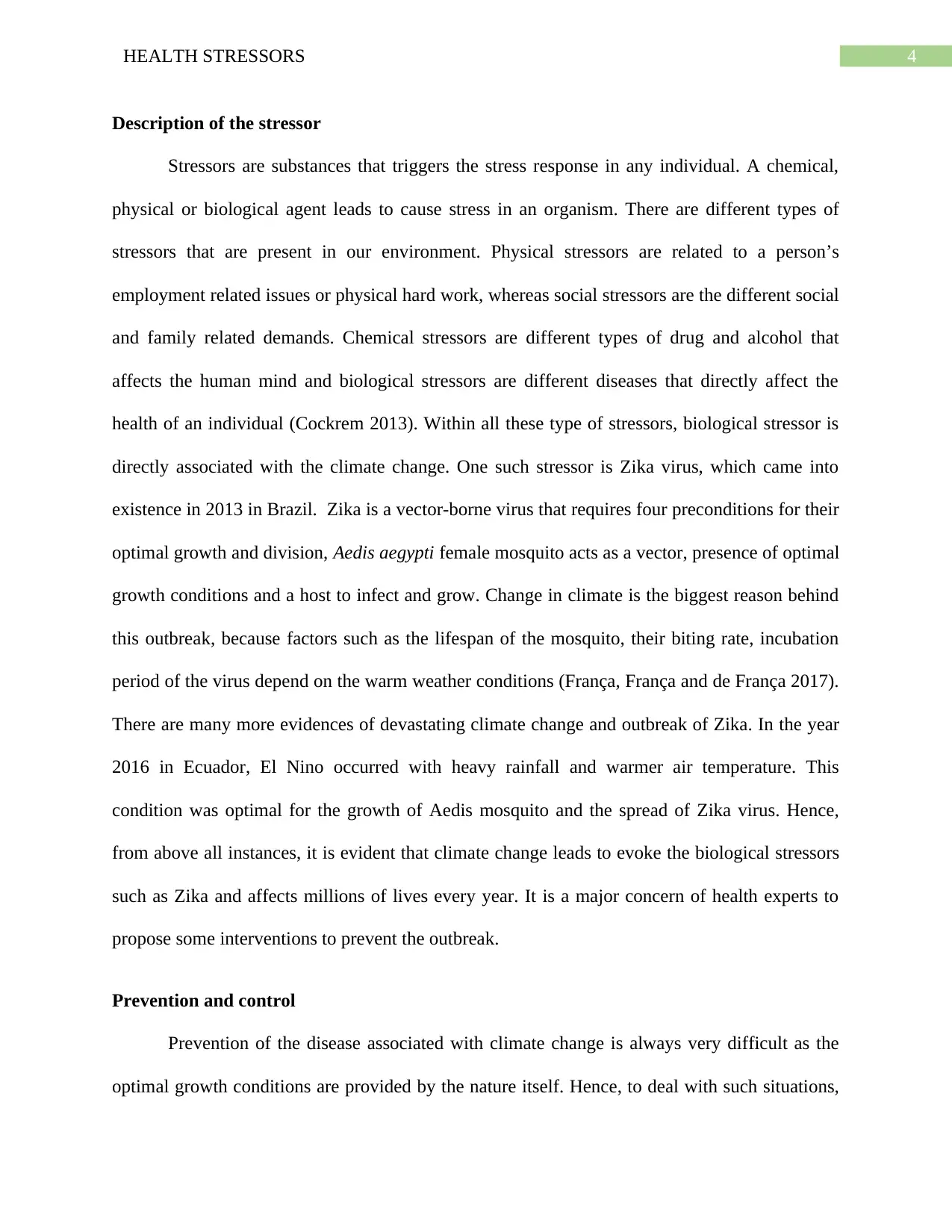
4HEALTH STRESSORS
Description of the stressor
Stressors are substances that triggers the stress response in any individual. A chemical,
physical or biological agent leads to cause stress in an organism. There are different types of
stressors that are present in our environment. Physical stressors are related to a person’s
employment related issues or physical hard work, whereas social stressors are the different social
and family related demands. Chemical stressors are different types of drug and alcohol that
affects the human mind and biological stressors are different diseases that directly affect the
health of an individual (Cockrem 2013). Within all these type of stressors, biological stressor is
directly associated with the climate change. One such stressor is Zika virus, which came into
existence in 2013 in Brazil. Zika is a vector-borne virus that requires four preconditions for their
optimal growth and division, Aedis aegypti female mosquito acts as a vector, presence of optimal
growth conditions and a host to infect and grow. Change in climate is the biggest reason behind
this outbreak, because factors such as the lifespan of the mosquito, their biting rate, incubation
period of the virus depend on the warm weather conditions (França, França and de França 2017).
There are many more evidences of devastating climate change and outbreak of Zika. In the year
2016 in Ecuador, El Nino occurred with heavy rainfall and warmer air temperature. This
condition was optimal for the growth of Aedis mosquito and the spread of Zika virus. Hence,
from above all instances, it is evident that climate change leads to evoke the biological stressors
such as Zika and affects millions of lives every year. It is a major concern of health experts to
propose some interventions to prevent the outbreak.
Prevention and control
Prevention of the disease associated with climate change is always very difficult as the
optimal growth conditions are provided by the nature itself. Hence, to deal with such situations,
Description of the stressor
Stressors are substances that triggers the stress response in any individual. A chemical,
physical or biological agent leads to cause stress in an organism. There are different types of
stressors that are present in our environment. Physical stressors are related to a person’s
employment related issues or physical hard work, whereas social stressors are the different social
and family related demands. Chemical stressors are different types of drug and alcohol that
affects the human mind and biological stressors are different diseases that directly affect the
health of an individual (Cockrem 2013). Within all these type of stressors, biological stressor is
directly associated with the climate change. One such stressor is Zika virus, which came into
existence in 2013 in Brazil. Zika is a vector-borne virus that requires four preconditions for their
optimal growth and division, Aedis aegypti female mosquito acts as a vector, presence of optimal
growth conditions and a host to infect and grow. Change in climate is the biggest reason behind
this outbreak, because factors such as the lifespan of the mosquito, their biting rate, incubation
period of the virus depend on the warm weather conditions (França, França and de França 2017).
There are many more evidences of devastating climate change and outbreak of Zika. In the year
2016 in Ecuador, El Nino occurred with heavy rainfall and warmer air temperature. This
condition was optimal for the growth of Aedis mosquito and the spread of Zika virus. Hence,
from above all instances, it is evident that climate change leads to evoke the biological stressors
such as Zika and affects millions of lives every year. It is a major concern of health experts to
propose some interventions to prevent the outbreak.
Prevention and control
Prevention of the disease associated with climate change is always very difficult as the
optimal growth conditions are provided by the nature itself. Hence, to deal with such situations,
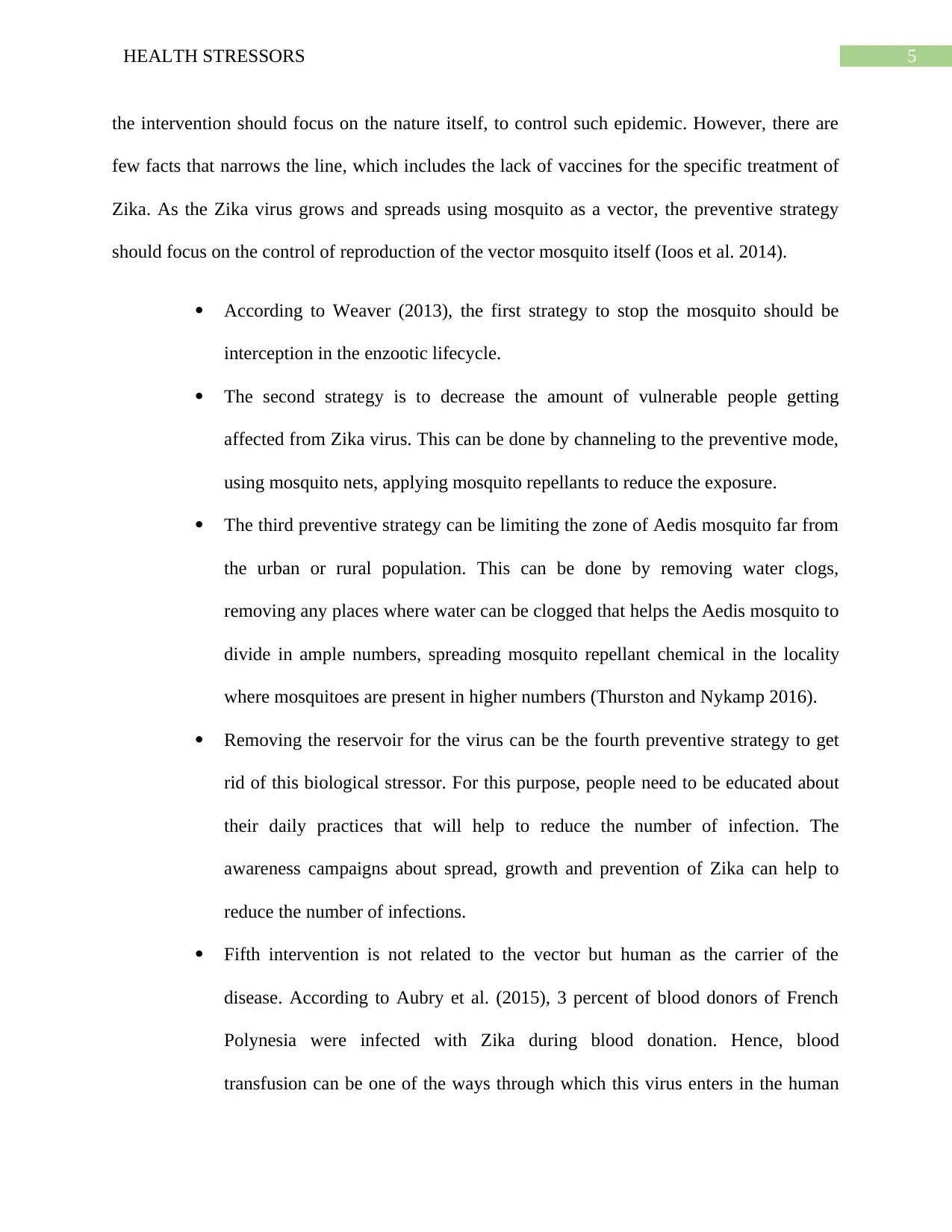
5HEALTH STRESSORS
the intervention should focus on the nature itself, to control such epidemic. However, there are
few facts that narrows the line, which includes the lack of vaccines for the specific treatment of
Zika. As the Zika virus grows and spreads using mosquito as a vector, the preventive strategy
should focus on the control of reproduction of the vector mosquito itself (Ioos et al. 2014).
According to Weaver (2013), the first strategy to stop the mosquito should be
interception in the enzootic lifecycle.
The second strategy is to decrease the amount of vulnerable people getting
affected from Zika virus. This can be done by channeling to the preventive mode,
using mosquito nets, applying mosquito repellants to reduce the exposure.
The third preventive strategy can be limiting the zone of Aedis mosquito far from
the urban or rural population. This can be done by removing water clogs,
removing any places where water can be clogged that helps the Aedis mosquito to
divide in ample numbers, spreading mosquito repellant chemical in the locality
where mosquitoes are present in higher numbers (Thurston and Nykamp 2016).
Removing the reservoir for the virus can be the fourth preventive strategy to get
rid of this biological stressor. For this purpose, people need to be educated about
their daily practices that will help to reduce the number of infection. The
awareness campaigns about spread, growth and prevention of Zika can help to
reduce the number of infections.
Fifth intervention is not related to the vector but human as the carrier of the
disease. According to Aubry et al. (2015), 3 percent of blood donors of French
Polynesia were infected with Zika during blood donation. Hence, blood
transfusion can be one of the ways through which this virus enters in the human
the intervention should focus on the nature itself, to control such epidemic. However, there are
few facts that narrows the line, which includes the lack of vaccines for the specific treatment of
Zika. As the Zika virus grows and spreads using mosquito as a vector, the preventive strategy
should focus on the control of reproduction of the vector mosquito itself (Ioos et al. 2014).
According to Weaver (2013), the first strategy to stop the mosquito should be
interception in the enzootic lifecycle.
The second strategy is to decrease the amount of vulnerable people getting
affected from Zika virus. This can be done by channeling to the preventive mode,
using mosquito nets, applying mosquito repellants to reduce the exposure.
The third preventive strategy can be limiting the zone of Aedis mosquito far from
the urban or rural population. This can be done by removing water clogs,
removing any places where water can be clogged that helps the Aedis mosquito to
divide in ample numbers, spreading mosquito repellant chemical in the locality
where mosquitoes are present in higher numbers (Thurston and Nykamp 2016).
Removing the reservoir for the virus can be the fourth preventive strategy to get
rid of this biological stressor. For this purpose, people need to be educated about
their daily practices that will help to reduce the number of infection. The
awareness campaigns about spread, growth and prevention of Zika can help to
reduce the number of infections.
Fifth intervention is not related to the vector but human as the carrier of the
disease. According to Aubry et al. (2015), 3 percent of blood donors of French
Polynesia were infected with Zika during blood donation. Hence, blood
transfusion can be one of the ways through which this virus enters in the human
⊘ This is a preview!⊘
Do you want full access?
Subscribe today to unlock all pages.

Trusted by 1+ million students worldwide
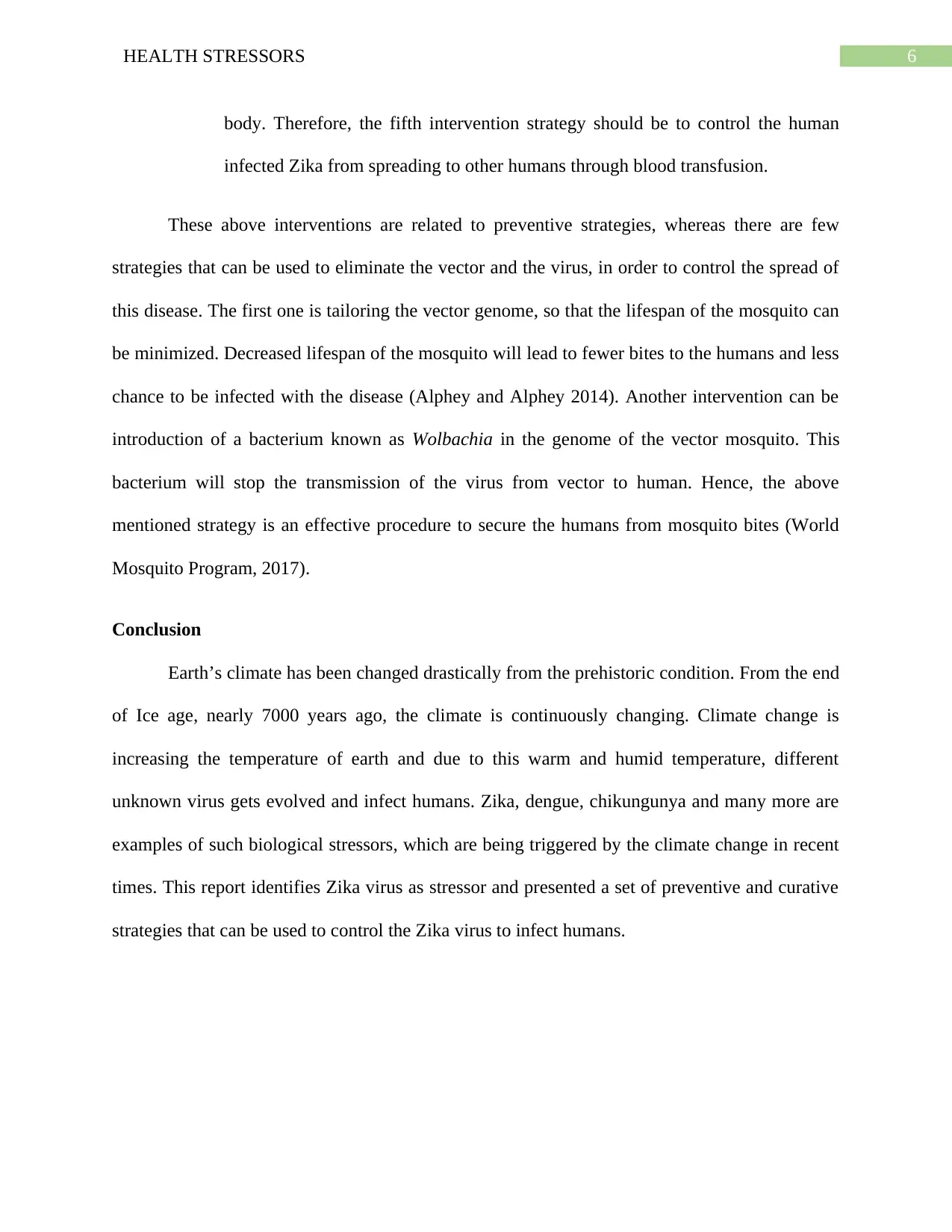
6HEALTH STRESSORS
body. Therefore, the fifth intervention strategy should be to control the human
infected Zika from spreading to other humans through blood transfusion.
These above interventions are related to preventive strategies, whereas there are few
strategies that can be used to eliminate the vector and the virus, in order to control the spread of
this disease. The first one is tailoring the vector genome, so that the lifespan of the mosquito can
be minimized. Decreased lifespan of the mosquito will lead to fewer bites to the humans and less
chance to be infected with the disease (Alphey and Alphey 2014). Another intervention can be
introduction of a bacterium known as Wolbachia in the genome of the vector mosquito. This
bacterium will stop the transmission of the virus from vector to human. Hence, the above
mentioned strategy is an effective procedure to secure the humans from mosquito bites (World
Mosquito Program, 2017).
Conclusion
Earth’s climate has been changed drastically from the prehistoric condition. From the end
of Ice age, nearly 7000 years ago, the climate is continuously changing. Climate change is
increasing the temperature of earth and due to this warm and humid temperature, different
unknown virus gets evolved and infect humans. Zika, dengue, chikungunya and many more are
examples of such biological stressors, which are being triggered by the climate change in recent
times. This report identifies Zika virus as stressor and presented a set of preventive and curative
strategies that can be used to control the Zika virus to infect humans.
body. Therefore, the fifth intervention strategy should be to control the human
infected Zika from spreading to other humans through blood transfusion.
These above interventions are related to preventive strategies, whereas there are few
strategies that can be used to eliminate the vector and the virus, in order to control the spread of
this disease. The first one is tailoring the vector genome, so that the lifespan of the mosquito can
be minimized. Decreased lifespan of the mosquito will lead to fewer bites to the humans and less
chance to be infected with the disease (Alphey and Alphey 2014). Another intervention can be
introduction of a bacterium known as Wolbachia in the genome of the vector mosquito. This
bacterium will stop the transmission of the virus from vector to human. Hence, the above
mentioned strategy is an effective procedure to secure the humans from mosquito bites (World
Mosquito Program, 2017).
Conclusion
Earth’s climate has been changed drastically from the prehistoric condition. From the end
of Ice age, nearly 7000 years ago, the climate is continuously changing. Climate change is
increasing the temperature of earth and due to this warm and humid temperature, different
unknown virus gets evolved and infect humans. Zika, dengue, chikungunya and many more are
examples of such biological stressors, which are being triggered by the climate change in recent
times. This report identifies Zika virus as stressor and presented a set of preventive and curative
strategies that can be used to control the Zika virus to infect humans.
Paraphrase This Document
Need a fresh take? Get an instant paraphrase of this document with our AI Paraphraser
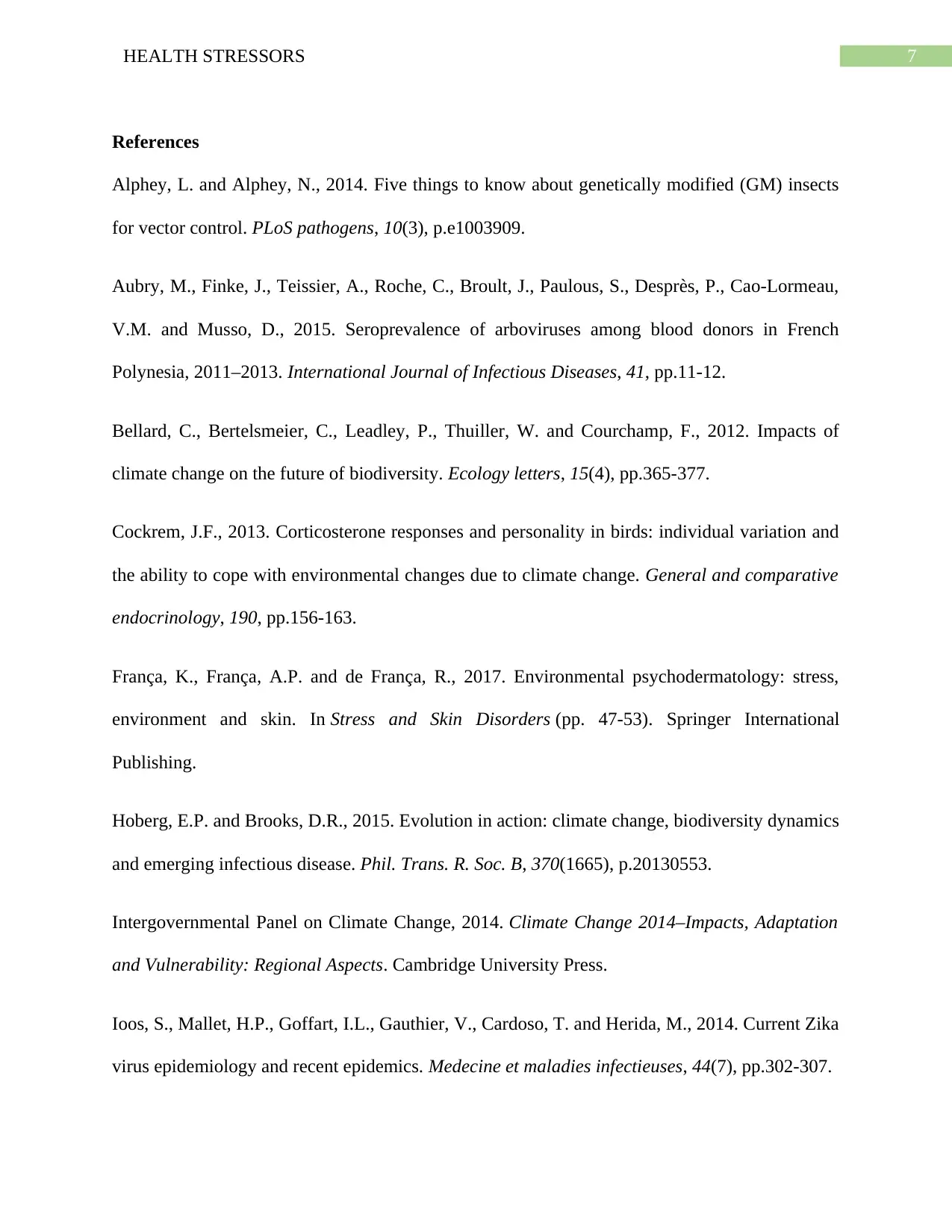
7HEALTH STRESSORS
References
Alphey, L. and Alphey, N., 2014. Five things to know about genetically modified (GM) insects
for vector control. PLoS pathogens, 10(3), p.e1003909.
Aubry, M., Finke, J., Teissier, A., Roche, C., Broult, J., Paulous, S., Desprès, P., Cao-Lormeau,
V.M. and Musso, D., 2015. Seroprevalence of arboviruses among blood donors in French
Polynesia, 2011–2013. International Journal of Infectious Diseases, 41, pp.11-12.
Bellard, C., Bertelsmeier, C., Leadley, P., Thuiller, W. and Courchamp, F., 2012. Impacts of
climate change on the future of biodiversity. Ecology letters, 15(4), pp.365-377.
Cockrem, J.F., 2013. Corticosterone responses and personality in birds: individual variation and
the ability to cope with environmental changes due to climate change. General and comparative
endocrinology, 190, pp.156-163.
França, K., França, A.P. and de França, R., 2017. Environmental psychodermatology: stress,
environment and skin. In Stress and Skin Disorders (pp. 47-53). Springer International
Publishing.
Hoberg, E.P. and Brooks, D.R., 2015. Evolution in action: climate change, biodiversity dynamics
and emerging infectious disease. Phil. Trans. R. Soc. B, 370(1665), p.20130553.
Intergovernmental Panel on Climate Change, 2014. Climate Change 2014–Impacts, Adaptation
and Vulnerability: Regional Aspects. Cambridge University Press.
Ioos, S., Mallet, H.P., Goffart, I.L., Gauthier, V., Cardoso, T. and Herida, M., 2014. Current Zika
virus epidemiology and recent epidemics. Medecine et maladies infectieuses, 44(7), pp.302-307.
References
Alphey, L. and Alphey, N., 2014. Five things to know about genetically modified (GM) insects
for vector control. PLoS pathogens, 10(3), p.e1003909.
Aubry, M., Finke, J., Teissier, A., Roche, C., Broult, J., Paulous, S., Desprès, P., Cao-Lormeau,
V.M. and Musso, D., 2015. Seroprevalence of arboviruses among blood donors in French
Polynesia, 2011–2013. International Journal of Infectious Diseases, 41, pp.11-12.
Bellard, C., Bertelsmeier, C., Leadley, P., Thuiller, W. and Courchamp, F., 2012. Impacts of
climate change on the future of biodiversity. Ecology letters, 15(4), pp.365-377.
Cockrem, J.F., 2013. Corticosterone responses and personality in birds: individual variation and
the ability to cope with environmental changes due to climate change. General and comparative
endocrinology, 190, pp.156-163.
França, K., França, A.P. and de França, R., 2017. Environmental psychodermatology: stress,
environment and skin. In Stress and Skin Disorders (pp. 47-53). Springer International
Publishing.
Hoberg, E.P. and Brooks, D.R., 2015. Evolution in action: climate change, biodiversity dynamics
and emerging infectious disease. Phil. Trans. R. Soc. B, 370(1665), p.20130553.
Intergovernmental Panel on Climate Change, 2014. Climate Change 2014–Impacts, Adaptation
and Vulnerability: Regional Aspects. Cambridge University Press.
Ioos, S., Mallet, H.P., Goffart, I.L., Gauthier, V., Cardoso, T. and Herida, M., 2014. Current Zika
virus epidemiology and recent epidemics. Medecine et maladies infectieuses, 44(7), pp.302-307.
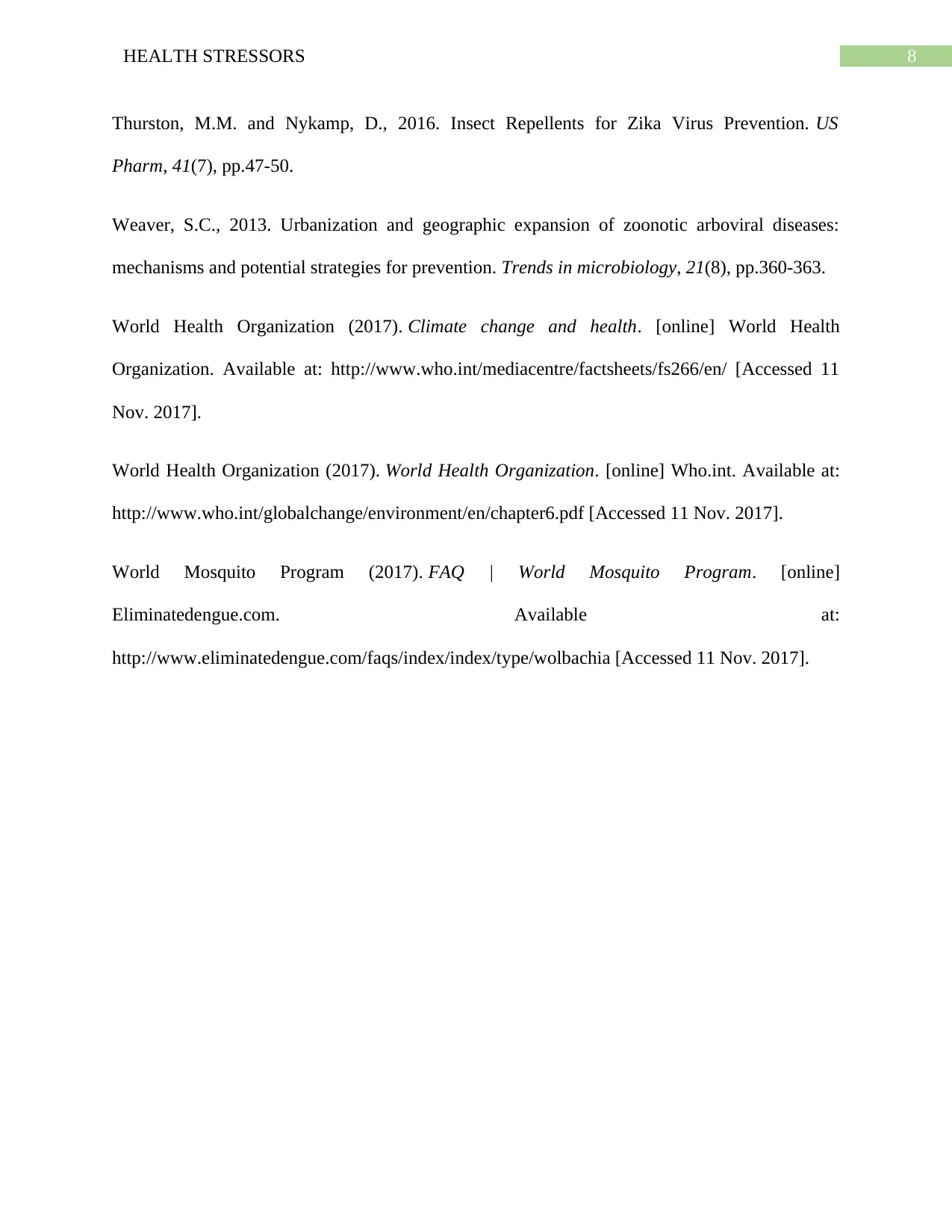
8HEALTH STRESSORS
Thurston, M.M. and Nykamp, D., 2016. Insect Repellents for Zika Virus Prevention. US
Pharm, 41(7), pp.47-50.
Weaver, S.C., 2013. Urbanization and geographic expansion of zoonotic arboviral diseases:
mechanisms and potential strategies for prevention. Trends in microbiology, 21(8), pp.360-363.
World Health Organization (2017). Climate change and health. [online] World Health
Organization. Available at: http://www.who.int/mediacentre/factsheets/fs266/en/ [Accessed 11
Nov. 2017].
World Health Organization (2017). World Health Organization. [online] Who.int. Available at:
http://www.who.int/globalchange/environment/en/chapter6.pdf [Accessed 11 Nov. 2017].
World Mosquito Program (2017). FAQ | World Mosquito Program. [online]
Eliminatedengue.com. Available at:
http://www.eliminatedengue.com/faqs/index/index/type/wolbachia [Accessed 11 Nov. 2017].
Thurston, M.M. and Nykamp, D., 2016. Insect Repellents for Zika Virus Prevention. US
Pharm, 41(7), pp.47-50.
Weaver, S.C., 2013. Urbanization and geographic expansion of zoonotic arboviral diseases:
mechanisms and potential strategies for prevention. Trends in microbiology, 21(8), pp.360-363.
World Health Organization (2017). Climate change and health. [online] World Health
Organization. Available at: http://www.who.int/mediacentre/factsheets/fs266/en/ [Accessed 11
Nov. 2017].
World Health Organization (2017). World Health Organization. [online] Who.int. Available at:
http://www.who.int/globalchange/environment/en/chapter6.pdf [Accessed 11 Nov. 2017].
World Mosquito Program (2017). FAQ | World Mosquito Program. [online]
Eliminatedengue.com. Available at:
http://www.eliminatedengue.com/faqs/index/index/type/wolbachia [Accessed 11 Nov. 2017].
⊘ This is a preview!⊘
Do you want full access?
Subscribe today to unlock all pages.

Trusted by 1+ million students worldwide
1 out of 9
Related Documents
Your All-in-One AI-Powered Toolkit for Academic Success.
+13062052269
info@desklib.com
Available 24*7 on WhatsApp / Email
![[object Object]](/_next/static/media/star-bottom.7253800d.svg)
Unlock your academic potential
Copyright © 2020–2025 A2Z Services. All Rights Reserved. Developed and managed by ZUCOL.





